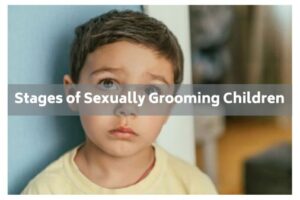Sexually Grooming Children – List of Stages

It is estimated that about 12 to 27% of girls and 4 to 5% of boys are victims of child sexual abuse. Of all child sexual abuse victims, about 30 to 45% were groomed by their abusers.
Sexual predators can be almost anywhere in our society. They may hold places of honor, authority, or respect, making it easier for predators. One thing that many sexual abusers have in common is the ability to groom children. These predators often have access to children and can spend time with them to prepare them for molestation without having them report the abuse.
Sexually Grooming Children
Sexual grooming is a tool that sexual predators use to prepare their victims prior to abuse. These manipulative behaviors help get children involved in the molestation in a way that gets them to participate. Grooming can take place online or in person. The abuser is often a person of trust in the child’s life. It may be a relative, a teacher, a member of the clergy, a coach, or anyone else who has gained the child’s trust. There are various stages or forms of grooming.
Read on as our California child sexual abuse attorney at Beck Law P.C. explains more about the stages of sexual grooming.
Defining the Stages of Sexually Grooming Children
Most often, perpetrators go through a variety of stages to groom a child for sexual contact. Grooming aims to get the child to accept the sexual behavior without reporting it to their parents or other authorities. While there is no generally accepted model of grooming, some behaviors were established by researchers as often used in manipulating children by adult sexual predators.
Selecting the Victim
The sexual predator chooses victims wisely. They watch children to find those who seem most vulnerable. They may choose to sexually groom a child who is small or young. They look for children who might have low self-esteem or those who appear to be more trusting of authority figures. Sometimes, a child from a broken home or a home where there is discord may be more appealing because the child might have less ability to report the incident.
Access and Isolation
In order to molest a child, the perpetrator must have some time alone with the child. In many instances, the adult is able to orchestrate these times of isolation so they can be with a child without interference. They often create times and places where they are alone with the child so the child feels it is normal.
Developing Trust
The adult wants to develop trust with the child so that the child feels a strong bond. Sometimes, trust is inherent in the relationship between the child and the adult. For instance, clergy members, teachers, and coaches are already established as trustworthy figures in a child’s mind.
Desensitizing
The adult tries to normalize the sexual behaviors. They repeat the behaviors, sometimes molesting a child over and over again. In some cases, the abuse goes further and further in subsequent encounters. A child eventually begins to think that the behavior is not abusive.
Sexual Grooming – Maintenance Behaviors
Once sexual contact has begun, the perpetrator must continue behaviors that will prevent the victim from reporting the abuse. The abuser seeks to make the sexual contact seem normal and not at all wrong.
Child sexual abuse can impact a child for the rest of their life. It is important to understand how sexually grooming children works so you can spot the signs in your child. If you or your child were sexually abused, you may be owed compensation from the offender and their company or workplace in some cases. If you live in San Francisco, Los Angeles, San Diego or elsewhere in California, contact Beck Law to discuss your situation in confidence with our California child sexual abuse lawyer. We will help you seek justice for child sexual abuse. Call Beck Law P.C. today at (707) 576-7175 to schedule a consultation.



